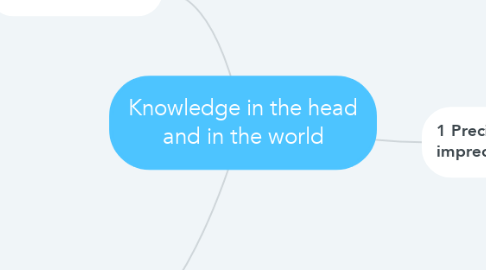
1. 1 Precise behavior from imprecise knowledge
1.1. 4 reasons people take good action whilst having imperfect knwoledge
1.1.1. World-knowledge replaces head-kn
1.1.2. Precision is not required for success
1.1.3. Designer assumes natural constraints that do not exist in reality
1.1.4. Designer assumes cultural constraints that do not exist in reality
1.2. 2 types of knowledge
1.2.1. Knowledge of
1.2.1.1. Understanding properties and principles of a thing with no goal in mind
1.2.1.2. Becomes Kn-how in practice
1.2.2. Knowledge how
1.2.2.1. Understanding the use of a thing to accomplish goal
1.2.2.2. Practical knowledge, mostly not based on theoretical knowledge (talent)
1.2.3. Precision is important
1.2.3.1. Ppl expect everyday ibjects (money) to be simple and won't invest time and effort learning to use them
1.2.3.2. When object is used to perform high value task (100 dollar bill) ppl will dedicate time and attention to learning
1.3. Constrants simplify memory
1.3.1. We use constraints to make it easy to remember things
1.3.1.1. The "verse" system to remember poems
1.3.1.2. Dial system (twist than press a button)
1.3.2. Violation of constrains can be used to cause user to pay attention to something
1.3.2.1. Bt mostly designers should leverage, not violate the constraints
2. 2 Trade-off between kn-world and kn-head
2.1. The trade-off
2.1.1. World-Kn needs no mental ability
2.1.1.1. We don't need to remember things to make it work
2.1.1.2. Error-prone and time-consuming
2.1.1.3. We gain nothing from the experience
2.1.2. Head-kn is based on assumptions
2.1.2.1. If it worked that way that time, it'll work this way this time
2.1.2.2. Requires knowledge in advance of taking action
2.1.3. The design choices of making something that needs assumptions and knowledge are based on 2 questions
2.1.3.1. How difficult is the task
2.1.3.2. How often will the user perform it
3. 3 Natural mapping
3.1. Example of combining both knowledges
3.1.1. Natural mapping is when link btwn control and object to be controlled is obvious
3.1.2. Three levels of mapping
3.1.2.1. Best mapping
3.1.2.1.1. Controls mounted directly on the item to be controlled
3.1.2.2. Second-best mapping
3.1.2.2.1. Controls as close as pssble to object
3.1.2.3. third-best mapping
3.1.2.3.1. Controles spatial arranged in same way as object
3.2. Varies with Culture
3.2.1. In Asia top button is down, and up button is up
3.2.2. This is a difference in perceiving time and "the future"
